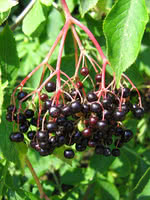Mon-Fri 9am - 5pm Mountain time
Berry Blue Haskap (Honeyberry) vs Black Elderberry
Sambucus canadensis
Lonicera caerulea Berry Blue
NOT AVAILABLE THIS SEASON - MIGHT RETURN
NOT AVAILABLE THIS SEASON - MIGHT RETURN
Black Elderberry is a deciduous shrub native to eastern North America. You can plant this shrub in moist areas and it will help stabilize your soil. You can also use it on rural properties anywhere you'd use a lilac.
Black Elderberries are considered to be partially self-pollinating. So while they will still produce some berries without cross-pollination, planting with another variety will increase yields. Consider planting with Ranch Elderberry or Bob Gordon Elderberry.
Warning: the seeds, stems, leaves, roots, and uncooked berries of the Black Elderberry are poisonous to humans when eaten in quantity. You should cook the berries to make them safe for human consumption.
Berry Blue Honeyberry is a hardy deciduous shrub. Its fruit is deliciously tart and perfect for fresh eating or production.
Berry Blue is an early pollinating variety. Pair with other early pollinators to have a higher yield.
Aurora is a great companion variety.
Haskap is the Japanese name for these berries and this term has been adopted for the University of Saskatchewan varieties. In other areas they are more commonly known as Honeyberry which is why we call this Eastern European variety Honeyberry.
Black Elderberry Quick Facts
Berry Blue Haskap (Honeyberry) Quick Facts
Toxicity: leaves, stems, and uncooked berries are poisonous to humans

